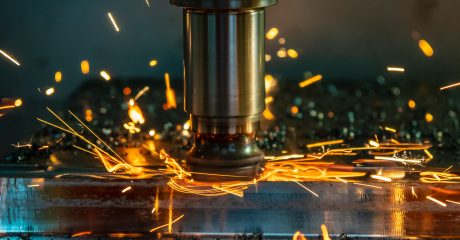Milling is a common manufacturing process where a rotating tool removes material from a stationary workpiece and delivers parts with a desired finish. While the milling operation is basic, there are different types of milling machines, and the most important characterization is based on the orientation of the cutting tool.
prBoth horizontal milling and vertical milling machines have unique operational characteristics that make them suitable for specific operations and applications. The following blog will take a look at the differences between the two and discuss their advantages and disadvantages.
A Brief Overview of Vertical Milling Machines
Vertical milling machines are the most common setup where you see the cutting tool in a vertical orientation. The tool presses against the stationary workpiece and removes the material according to your design requirements. In the industry, there are two types of vertical milling setups that are quite common – turret milling and bed milling.
The turret milling setup is generally used for small parts. In this setup, the spindle containing the cutting tool remains stationary while the turret bed can move. Bed milling machines are more common, especially in a traditional machine shop. In this setup, the spindle can move vertically while the bed moves horizontally. Through the combination of these movements, you can create grooves, bores, and various other features easily.
A Brief Overview of Horizontal Milling Machines
Horizontal milling machines are slightly different. The basic operations remain the same. You’ll still have a stationary workpiece and a rotating tool. However, the orientation of the tool would have a horizontal orientation.
Generally, these milling machines are more common in cases where you are dealing with larger parts or deeper cuts. The overarm design and horizontal rotation of the tool results in more cutting power and faster operations. Another important thing to note about horizontal machines is their ability to deal with angles. If you use a universal table with a horizontal setup, you’d ensure that the cutter can approach the workpiece from a variety of angles and better handle more complicated designs.
The Main Differences
As stated before, both horizontal and vertical approaches have a lot of similarities. The main reasons are the basic fundamentals of the milling process. They remain the same. However, there are some significant differences that affect the operations and results as well.
- The Orientation of the Spindle – This is perhaps the biggest difference between the two setups. The orientation of the spindle dictates how the cutter interacts with the workpiece. As their names suggest both types of machines have different orientations that allow you to either have the precision that vertical machining offers or the depth that a horizontal setup brings to the table.
Tool Geometry – Another difference is in the geometry of the tool. Vertical milling machines have a cylindrical tool that is both long and thin. Contrarily, horizontal machines have shorter and thicker tools that can deliver deeper cuts and deal with larger workpieces. Generally, these geometrical specifications directly affect the cutting specifications.
Cutting Specifications – The geometry of the tool has a direct effect on the cutting specifications and results. The vertical tool is more precise for smaller workpieces while horizontal tools, on the other hand, are shorter and thicker, which gives them the stability to sustain the resistance while creating deeper cuts.
Cost of Each Machine – Vertical machines are less costly when compared to their horizontal counterparts. That’s why vertical machines are more common around the world. Moreover, the operations and maintenance of vertical machines are also simpler, which makes them a more suitable choice for small-scale operations. Horizontal machines, on the other hand, are more expensive to purchase and maintain. Moreover, the experts who can handle these machines are scarce, which further increases the overall costs of CNC machining.
Material Removal Rate – When it comes to the removal rate, horizontal milling machines perform much better than their vertical counterparts because of their high stability and the ability to produce deeper cuts. Generally, vertical machines are popular for limited operations like facing and grooving because the cuts are not too deep and you can be precise as well. However, this limited cutting potential naturally means that the removal rate will be lower.
Number of Sides for Machining – We have already discussed how horizontal machines allow you to approach the workpiece at different angles and sides. Compared to that, vertical tools operate on a single plane. Furthermore, you can add certain add-ons and other features to the horizontal setup. These things are not available in a vertical mill, which limits the number of operations you can perform.
Contact Custom Tool and Grinding
Purchasing CNC equipment can be extremely expensive, especially when it comes to horizontal milling machines. A CNC machining service can be the answer for you as it allows you to have access to the best services without committing to investing exuberant amounts towards purchasing the necessary equipment.
When it comes to the best CNC machining services in the market, Custom Tool is the best choice. Our experienced team strives to provide you with comprehensive service where our experts can help optimize the design as well. For more information or for a quote, call us today!
